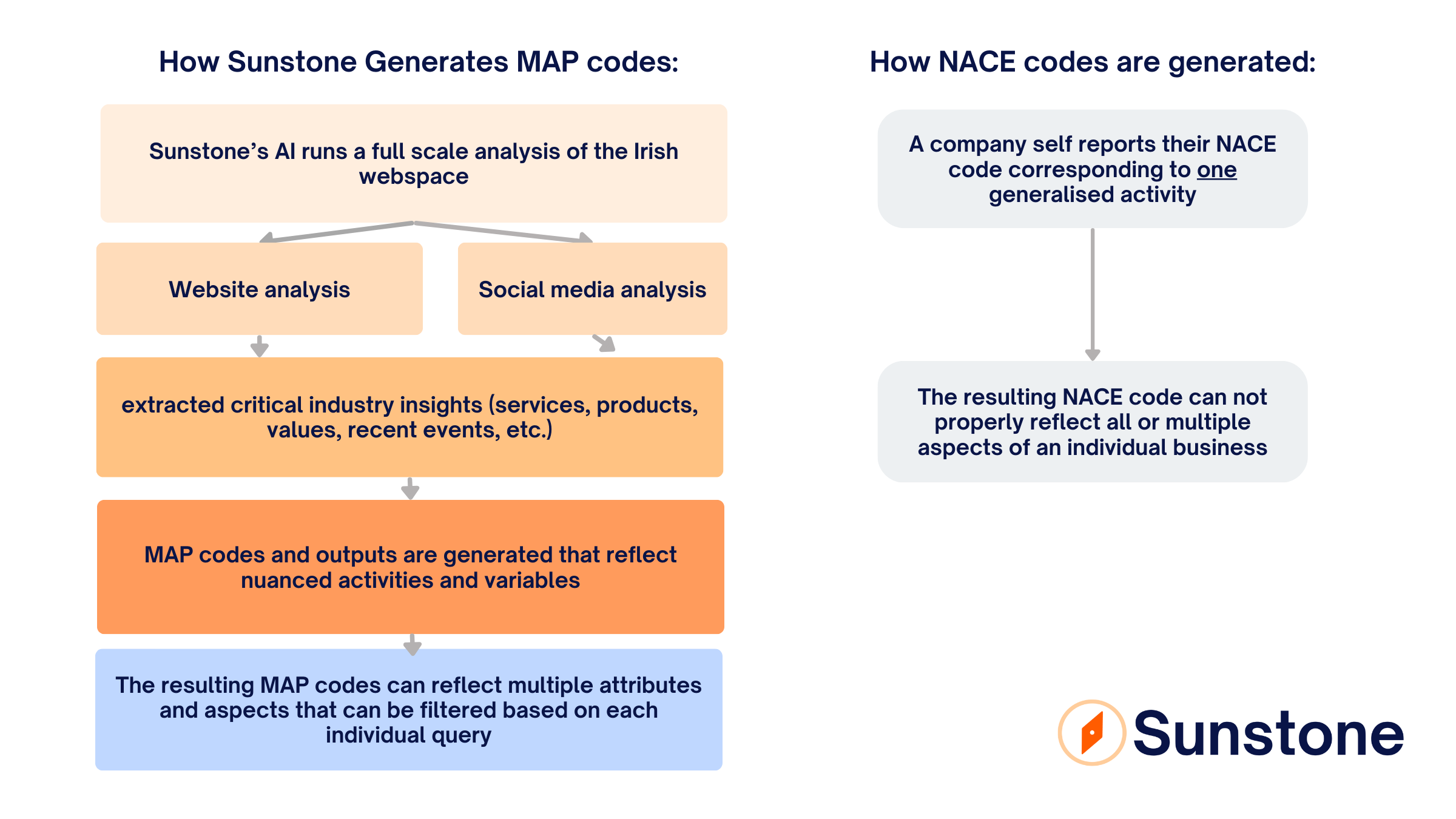MAP (Market Activity Profiling) – what it is and how it works
Market Activity Profiling is Sunstone’s very own advanced data classification system that analyses companies’ activities in the marketplace based on their digital footprints. We call this system Market Activity Profiling (or “MAP” for short).
MAP embraces a more holistic range of data variables, including products, services, financials, values, or even recent events with the aim of creating an interconnected data ecosystem that empowers businesses with the business information and knowledge that matters most.
The big problem with NACE codes:
Since 1970, NACE codes have been the most widely used classification system throughout Ireland and Europe to group organisations according to a generalised business activity. While once effective for general use, NACE codes have emerged with one fatal flaw limiting modern marketing; nuance.
Without the ability to provide any specific information on a business’ specific products, services, or values, NACE codes just aren’t as helpful as they used to be.
So, while NACE codes are widely available data points, they just can’t capture any nuance or diversity within industries or individual businesses.
Sunstone’s MAP data:


Using MAP as the basis for our data collection and classification, Sunstone has been able to build the largest, most accurate database in Ireland with a full range of data variables that have never before been offered or even collected by any other data company. Sunstone’s MAP data stored in our business database includes all CRO-registered companies, ensuring complete and accurate market coverage.
MAP marks a groundbreaking advancement in the realm of data classification, presenting a dynamic and relevant alternative to outdated NACE codes.
Examples of how our MAP codes are already reshaping the industry:
Through the power of artificial intelligence, MAP is reshaping traditional B2B marketing practices and introducing new opportunities that cater to each businesses’ personalised needs. Here are a few examples:
- Enhanced Market Segmentation: With MAP, businesses can achieve a more nuanced and detailed market segmentation. The system’s ability to analyze a company’s digital footprint—encompassing products, services, values, and recent events—enables a more dynamic and precise segmentation than what’s possible with traditional NACE codes. This can lead to more targeted marketing strategies and a better understanding of market dynamics.
- Improved Competitive Intelligence: MAP codes offer a more detailed view of a company’s activities and positioning, providing businesses with enhanced competitive intelligence. Companies can use this data to understand their competitors’ strategies, market positioning, and areas of focus in a way that was not possible with the more generalized NACE codes.
- Advanced Trend Analysis: By integrating a comprehensive range of data variables, including sentiment analysis and recent events, MAP allows for advanced trend analysis. Companies can identify emerging trends, shifts in market sentiment, and changes in consumer values more rapidly and accurately, enabling them to be more agile and responsive in their strategies.
- Customized Business Solutions: The detailed data provided by MAP enables businesses to develop more customized solutions and offerings. By understanding the nuances of different market segments and industry dynamics, companies can tailor their products, services, and marketing messages to meet the specific needs and preferences of their target audiences.
- Strategic Decision-Making: MAP codes empower businesses with a more robust data foundation for strategic decision-making. The comprehensive 360-degree view of the corporate landscape that MAP provides can inform a wide range of strategic decisions, from market entry and product development to mergers and acquisitions. With a deeper understanding of the market and competitors, companies can make more informed decisions that are aligned with the latest industry trends and consumer expectations.
